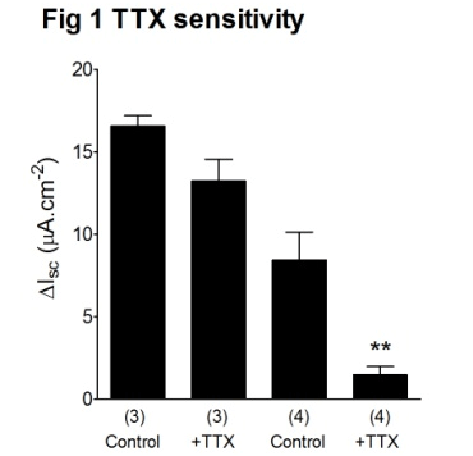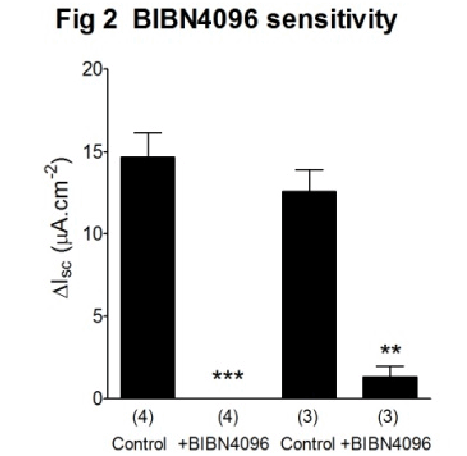Glucagon-Like Peptide-1 Receptor-Mediated Increases In Short-Circuit Current Are Dependent On Calcitonin Gene-Related Peptide Receptor Activation In Mouse Ascending Colon Mucosa Glucagon-like peptide-1 (GLP-1) is a hormone released from gastrointestinal L cells following ingestion of nutrients and is important in the control of diabetes and obesity due to its insulin-secreting and central satiety-inducing effects (see 1 for review). Amongst its many peripheral activities GLP-1 alters intestinal epithelial ion transport with the ascending colon mucosa demonstrating the greatest sensitivity to the GLP-1 receptor agonist, exendin 4, in the mouse (2). A new GLP-1 receptor (GLP-1R)-fluorescent mouse has provided a long overdue resolution of specific GLP-1R localisation in peripheral tissues (3). For example, some GLP-1R fluorescent cell bodies in the dorsal root ganglia also immunostained for the sensory transmitter, calcitonin gene-related peptide (CGRP) (3). Of particular interest to us was the observation that GLP-1R fluorescence was seen in colonic myenteric neurons that were also CGRP-positive (3), We thus set out to determine whether GLP-1 colonic activity was mediated by intrinsic enteric neurons and CGRP-specifically. Muscle-stripped, ascending colonic mucosa (devoid of myenteric but with intact submucosal innervation) from male or female mice (C57Bl6/129Sv background, >10 weeks old) were voltage-clamped in Ussing chambers as described previously (2) and the effects of rat alpha-CGRP (0.3-100 nM) on short-circuit current (Isc) were ascertained. We investigated the sensitivities of alpha-CGRP (10 nM) or exendin 4 (100 nM) to the neurotoxin, TTX (100 nM) or the CGRP receptor antagonist, BIBN4096 (10 nM). Student’s t-test was used to determine statistical significance. Basolateral additions of alpha-CGRP were concentration-dependent and increased Isc with a pEC50 value of 8.5 ± 0.2 (n=3-4). Responses to alpha-CGRP were insensitive to TTX pretreatment (Fig 1), which suggested a post-junctional CGRP receptor. In contrast, exendin 4 responses were inhibited by TTX (82.3%, P<0.01) indicating a submucosal neurogenic mechanism (Fig 1). Following BIBN4096 pretreatment, alpha-CGRP responses were abolished (P<0.001) and exendin 4 responses were attenuated by 89.5% (P<0.01), which demonstrated a dependence of the GLP-1R response on mucosal CGRP receptors (Fig 2).
From these results we conclude that GLP-1R responses in the mouse ascending colon mucosa are predominantly mediated via CGRP released from intrinsic submucosal neurons, the depolarisation of which results in direct stimulation of epithelial CGRP receptors and increased mucosal ion transport. (1) Parker P, et al., 2014, Exp Physiol, 99 1116-1120 (2) Joshi S, et al., 2013, Br J Pharmacol, 170 1092–1101 (3) Richards P, et al., 2014, Diabetes 63 1244-1233
|



